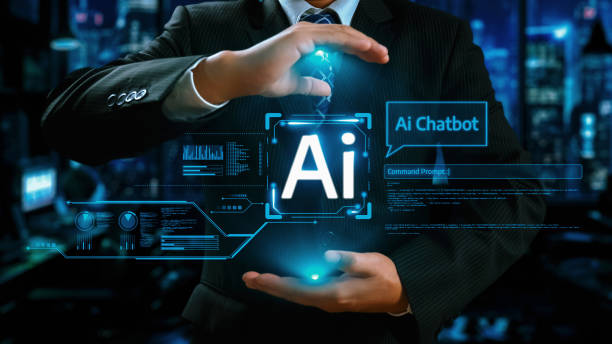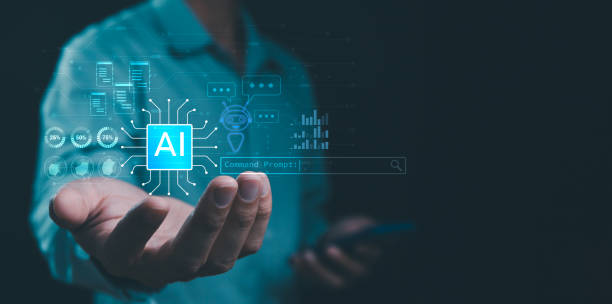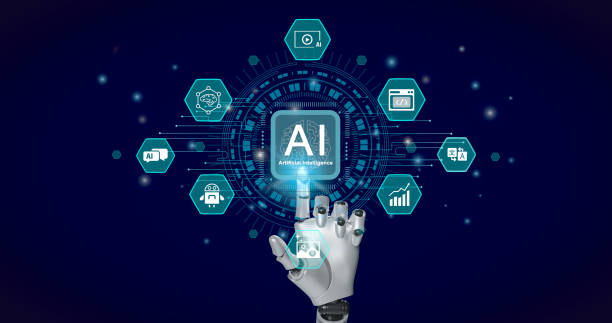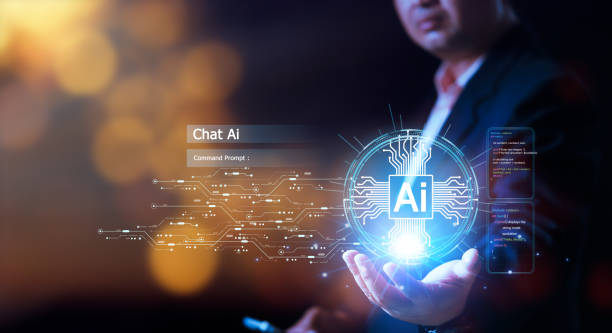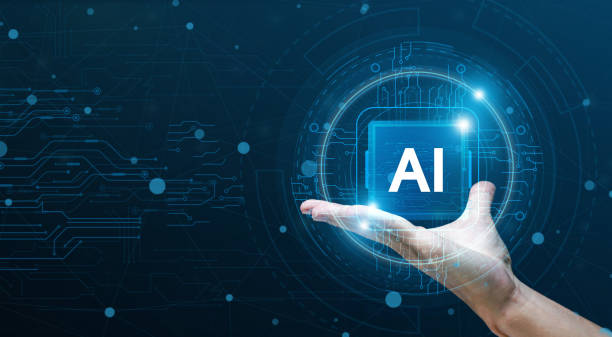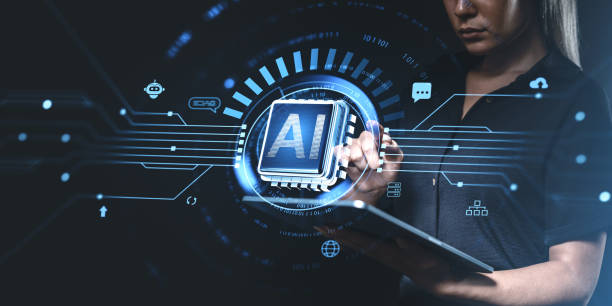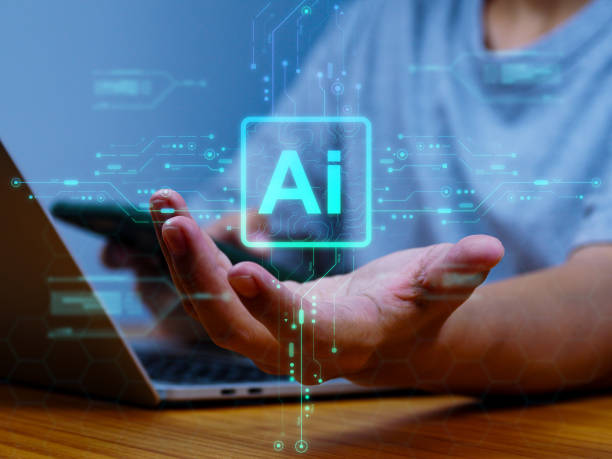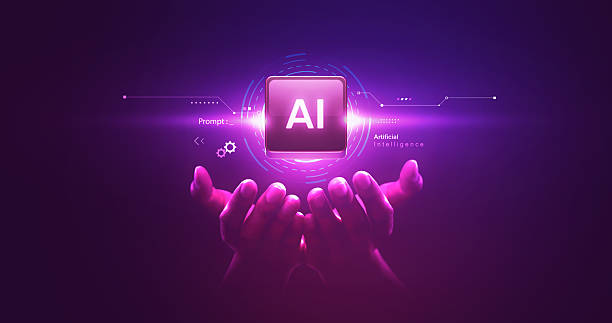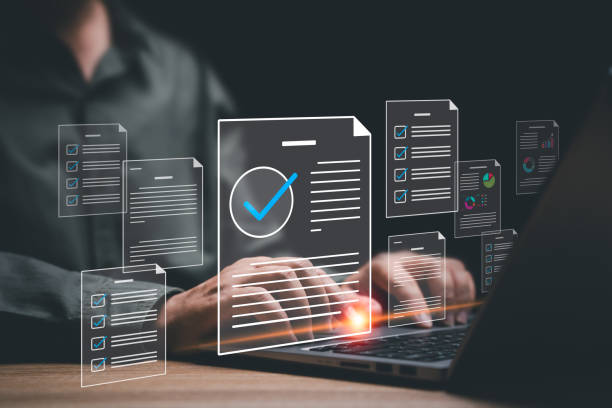What is an Artificial Intelligence Robot and How Does it Work?
#AI_Robot is a combination of two main fields: robotics and artificial intelligence.
Robotics deals with the construction and design of physical robots capable of performing various tasks.
Artificial intelligence also deals with the development of algorithms and systems that allow machines to think, learn, and make decisions.
When these two fields are combined, the result is a robot that is not only capable of moving and performing physical tasks, but can also make decisions and adapt its behavior based on the data and information it receives.
These robots can be used in various environments, from factories and warehouses to homes and hospitals.
The way an AI robot works is that it first collects environmental information through various sensors (such as cameras, microphones, and touch sensors).
This information is then sent to a processing system that uses artificial intelligence algorithms to analyze the data and make decisions.
Finally, the robot takes the necessary actions based on these decisions.
For example, a warehouse robot can identify products using cameras and machine vision algorithms and move them using robotic arms.
These robots can improve their performance and perform more complex tasks by continuously learning from their data and experiences.
In fact, the AI robot is a representative of the future of technology that can transform our lives and work.
Are you tired of your company’s website not meeting your expectations? With Rasaweb, design a professional website that showcases the true face of your business.
✅ Increase the attraction of new customers and sales leads
✅ Increase the credibility and trust of your brand among the audience
⚡ Get a free website design consultation!
Main Components of an AI Robot
An AI robot consists of several main components, each of which plays an important role in its overall performance.
These components include:
- Sensors Sensors are responsible for collecting information from the surrounding environment.
This information can include images, sounds, temperature, pressure, and other sensory data.
There are different types of sensors that are selected depending on the application of the robot. - Processor The processor is the thinking brain of the robot.
This part is responsible for processing the information collected by the sensors and making decisions based on artificial intelligence algorithms.
Processors can consist of microcontrollers, single-board computers, or even cloud systems. - Actuators Actuators are responsible for performing physical actions.
This part can include motors, pumps, robotic arms, and other devices that allow the robot to move and perform tasks. - Power Source The power source provides the energy needed for the robot to function.
This part can include batteries, solar cells, or connection to city electricity. - Software Software includes artificial intelligence algorithms, control programs, and other codes that allow the robot to think, learn, and perform tasks.
AI robot software is usually developed using programming languages such as Python, C++, and Java.
Click here to preview your posts with PRO themes ››
The cooperation and coordination between these components enables an AI robot to perform complex tasks with high accuracy and efficiency.
Diverse Applications of AI Robots in Various Industries
AI robots have extensive applications in various industries and are transforming the way things are done.
Some of these applications include:
- Manufacturing Industry AI robots are used on production lines to perform tasks such as assembly, packaging, and quality inspection.
These robots can work around the clock with high accuracy and without fatigue and increase productivity. - Healthcare Industry Surgical robots, rehabilitation robots, and nursing robots are among the applications of AI robots in this field.
These robots can play an important role in performing complex surgeries, helping patients in the rehabilitation process, and providing primary care to patients. - Logistics and Warehousing Industry Warehouse robots and transportation robots are among the applications of AI robots in this industry.
These robots can operate automatically in moving goods, sorting products, and managing warehouse inventory. - Agriculture Agricultural robots can help farmers in planting, maintaining, and harvesting crops.
These robots can use sensors and artificial intelligence algorithms to identify the different needs of plants and automatically supply the required water, fertilizer, and pesticides. - Customer Service Chatbots and virtual assistants are among the applications of AI robots in this area.
These robots can answer customer questions, solve their problems, and provide 24-hour support services.
These are just a few examples of the applications of AI robots in various industries.
With the advancement of technology, it is expected that the applications of these robots will become more widespread and diverse in the future.
| Industry | Applications |
|---|---|
| Manufacturing | Assembly, packaging, quality inspection |
| Healthcare | Surgery, rehabilitation, nursing |
| Logistics | Warehousing, transportation |
Challenges and Limitations of AI Robots
Despite its many advantages, AI robots also face challenges and limitations.
Some of these challenges include:
- High Cost The design, construction, and maintenance of AI robots can be very expensive.
This cost includes the cost of parts, software, and specialized labor. - Need for Expertise The development and use of AI robots requires a high level of knowledge and expertise in various fields such as robotics, artificial intelligence, and software engineering.
- Technical Limitations AI robots still have technical limitations in some areas.
For example, robots may have difficulty in recognizing and understanding natural language, making decisions in complex situations, and adapting to unpredictable environments. - Ethical Issues The use of AI robots raises various ethical issues.
For example, there are questions about the accountability of robots in case of error, protecting the privacy of individuals, and the impact of robots on employment. - Security AI robots can be vulnerable to cyberattacks.
Hackers can gain control of robots by infiltrating their systems and use them for malicious purposes.
Addressing these challenges and overcoming the limitations is essential for expanding the application of AI robots in the future.
Are you dissatisfied with low sales on your online store?
Rasaweb is your solution to having a professional and high-selling online store.
✅ Significant increase in sales and revenue
✅ Easy and enjoyable shopping experience for customers
⚡ Get a free consultation from Rasaweb right now!
The Future of AI Robots: Advances and Transformations
The future of AI robots is very bright and full of transformation.
With the advancement of technology, robots are expected to become smarter, more capable, and more practical.
Some of the possible advances and transformations in the future include:
- Increased Intelligence and Learning Ability Using advanced artificial intelligence algorithms, robots will be able to learn independently, make decisions, and adapt to new conditions.
- Development of More Advanced Sensors New sensors will allow robots to collect more information from the surrounding environment and have a better understanding of it.
- Improved Motion Capabilities Using more advanced actuators, robots will be able to perform more complex movements and move in more difficult environments.
- Increased Human-Robot Collaboration Robots will increasingly collaborate with humans and assist them in performing various tasks.
- Expansion of Applications The applications of AI robots will expand in various industries, and robots will play a more important role in our daily lives.
In general, the future of AI robots will be accompanied by innovation, progress, and transformation, and these robots will significantly affect our lives and work.
AI robots will play an important role in various fields such as self-driving cars, smart homes, and even space exploration.
How AI Robots Learn and Are Trained
The learning and training of AI robots is done through various methods.
Some of these methods include:
- Supervised Learning In this method, the robot is trained using labeled data.
This means that each input data is associated with a correct output.
By analyzing this data, the robot learns how to map inputs to correct outputs. - Unsupervised Learning In this method, the robot is trained using unlabeled data.
The robot must independently identify the patterns and structures in the data. - Reinforcement Learning In this method, the robot receives feedback by performing various actions in an environment.
This feedback can be positive (reward) or negative (penalty).
By repeating this process, the robot learns how to perform actions that bring the most reward. - Deep Learning This method uses artificial neural networks with multiple layers to learn complex patterns in data.
Deep learning enables robots to perform tasks such as face recognition, voice recognition, and language translation with high accuracy.
Choosing the appropriate method for learning and training an AI robot depends on the type of task and the available data.
Training an AI robot is a complex and time-consuming process that requires a high level of knowledge and expertise.
The Importance of Security in AI Robots
Security is of high importance in AI robots.
Robots can be vulnerable to cyberattacks, and hackers can gain control of robots by infiltrating their systems and use them for malicious purposes.
Some of the common security threats in robots include:
- Infiltration of Control Systems Hackers can disrupt the operation of robots by infiltrating their control systems or sending them malicious commands.
- Information Theft Robots may collect and store sensitive information.
Hackers can violate the privacy of individuals by stealing this information or use this information for criminal purposes. - Using Robots for Cyberattacks Hackers can use robots as part of a botnet to carry out cyberattacks such as DDoS attacks.
- Physical Damage Hackers can manipulate the systems of robots to cause them to inflict physical damage to people or property.
To counter these threats, appropriate security measures must be considered in the design, development, and use of AI robots.
These measures include using strong encryption, two-factor authentication, and continuous monitoring of robot systems.
In today’s world, ensuring the security of AI robots is as important as their efficiency and intelligence.
| Security Threat | Description |
|---|---|
| Infiltration of Control Systems | Disrupting robot operation and sending malicious commands |
| Information Theft | Violating privacy and using information for criminal purposes |
| Cyberattacks | Using robots for DDoS attacks |
The Impact of AI Robots on the Labor Market and Employment
AI robots have a significant impact on the labor market and employment.
On the one hand, robots can increase productivity and reduce costs by automating repetitive and dangerous tasks.
This can lead to increased profitability for companies and create new opportunities for growth and development.
On the other hand, automation can lead to job losses, especially in jobs that require low and medium skills.
For example, robots can replace production line workers, truck drivers, and telephone operators.
Therefore, educating and training the workforce for new jobs related to robots and artificial intelligence is very important.
Creating new job opportunities in the field of designing, building, maintaining, and programming robots can help compensate for lost jobs.
Also, creating support policies for workers who lose their jobs can help reduce the negative effects of automation on society.
In general, the impact of AI robots on the labor market and employment is a complex and multifaceted issue that requires careful consideration and proper planning.
Did you know that a weak company website takes away a lot of opportunities from you daily? Solve this problem forever by designing a professional company website by Rasaweb!
✅ Creating a powerful and reliable image of your brand
✅ Targeted attraction of new customers and increased sales
⚡ [Get free website design consultation]
Ethical Issues Related to the Development and Use of AI Robots
The development and use of AI robots raises various ethical issues.
Some of these issues include:
- Accountability In the event of an error or accident caused by a robot, who will be responsible? Is the manufacturer, the user, or the robot itself responsible?
- Privacy Robots may collect and store personal information of individuals.
How can the privacy of individuals be ensured against robots? - Discrimination Robots may make discriminatory decisions based on their training data.
How can discrimination be prevented in robot decision-making? - Security Robots can be vulnerable to cyberattacks, and hackers can use them for malicious purposes.
How can the security of robots be ensured against cyberattacks? - Impact on Employment Automating tasks by robots can lead to job losses.
How can the negative effects of automation on employment be prevented?
These ethical issues require careful consideration and the development of appropriate laws and regulations.
To solve these issues, there should be a broad dialogue between experts, policymakers, and the general public.
AI robots with their vast potential can help improve human lives, but we must prevent the occurrence of ethical problems resulting from their misuse.
Key Points in Choosing and Buying an AI Robot
Choosing and buying an AI robot can be a complex process.
To make the best choice, you should pay attention to the following points:
- Determine Needs First of all, you must accurately identify your needs.
What tasks do you want the robot to perform? What features are important to you? - Research and Review Review the different types of AI robots and compare their features, prices, and user reviews.
- Pay Attention to Compatibility Make sure that the robot you choose is compatible with your existing systems and equipment.
- Check Security Check the security of the robot and make sure that appropriate security measures have been taken to prevent cyberattacks.
- Consider Cost Consider the cost of purchasing, maintaining, and repairing the robot.
- Get Advice If needed, seek help from experts and consultants in this field.
By paying attention to these points, you can choose a suitable AI robot for your needs and benefit from its advantages.
Before buying, be sure to ask the seller to show you the robot and explain how it works.
Also, check the warranty and after-sales service.
A correct choice can increase your productivity and help improve your business.
Frequently Asked Questions
| Question | Answer |
|---|---|
| What is an Artificial Intelligence Robot? | An Artificial Intelligence Robot (AI Robot) is a machine capable of understanding the environment, reasoning, learning and making decisions to perform tasks independently. |
| What is the difference between regular robots and artificial intelligence robots? | Regular robots perform repetitive tasks based on pre-programming, while artificial intelligence robots can learn from experience, interact dynamically with the environment, and even behave in a way that resembles human intelligence. |
| What are the main applications of artificial intelligence robots? | They have applications in industries (manufacturing, assembly), medicine (surgery, diagnosis), services (customer support, home), exploration (space, underwater) and many other fields. |
| What technologies are used in the construction of artificial intelligence robots? | Machine Learning, Computer Vision, Natural Language Processing, Deep Learning and Robotics are among the key technologies. |
| Can artificial intelligence robots have emotions? | Currently, robots do not have emotions in the human sense. They can recognize and respond to emotions, but they do not experience emotions themselves. |
| What are the main challenges in developing artificial intelligence robots? | Safety, reliability, ethics, autonomy, adaptation to complex environments and natural interaction with humans are important challenges. |
| How do artificial intelligence robots learn? | They are usually trained using a large volume of data, machine learning algorithms and deep learning to identify patterns and make decisions. |
| Examples of artificial intelligence robots in everyday life? | Smart robotic vacuum cleaners, customer support chat robots, self-driving cars and surgical robots in hospitals. |
| Are artificial intelligence robots a threat to human jobs? | Some repetitive jobs may be automated, but at the same time, robots can increase productivity and create new jobs in the development, maintenance and monitoring of these systems. |
| How is the future of artificial intelligence robots predicted? | They are expected to become smarter, more autonomous and capable of performing more complex tasks and will be in closer interaction with humans in different environments. |
And other services of Rasa Web advertising agency in the field of advertising
Smart Customer Journey Map: A creative platform to improve online growth by optimizing key pages.
Smart Digital Advertising: A new service to increase website visits through the use of real data.
Smart Advertising Campaign: A creative platform to improve customer acquisition by customizing the user experience.
Smart Brand Identity: Designed for businesses looking to increase sales through attractive user interface design.
Smart Marketplace: An effective tool to attract customers with the help of marketing automation.
And more than hundreds of other services in the field of internet advertising, advertising consulting and organizational solutions
Internet Advertising | Advertising Strategy | Reportage Ad
Resources
What is Artificial Intelligence?
,Artificial Intelligence
,What is Artificial Intelligence?
,Smart Robot, Future Facing the Future
? Are you ready to take your business to the digital world? Rasaweb Digital Marketing Agency, offering services such as Modern User Interface Website Design, professional SEO, and social media management, paves the way for the growth and brilliance of your business in the online space. Contact us now for a free consultation and to learn more about our services.
📍 Tehran, Mirdamad Street, next to the Central Bank, South Kazerun Alley, Ramin Alley No. 6

